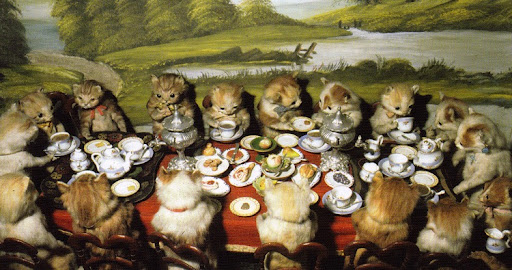
The Kittens' Tea Party
Apart from the simulations of human situations, he had also added examples of bizarrely deformed animals such as two-headed lambs and four-legged chickens. Potter's collection, billed as "Mr Potter's Museum of Curiosities” was a well-known and popular example of "Victorian whimsy" for many years, even after Potter's death. Special coach trips from Brighton were arranged and the village and Potter's museum were so popular that an extension was built to the platform at Bramber railway station.
As a boy, Potter taught himself the art of preserving animals and when his sister, Jane, showed him an illustrated book of nursery rhymes, Potter was inspired to produced what was to become the centerpiece of his museum, a diorama of "The Death and Burial of Cock Robin", which included 98 species of British birds. This was so well-received that in 1861, he opened a separate display in the summer house of the pub. While satisfying the Victorian demand for traditional stuffed animals to earn a living, Potter continued creating his dioramas and expanded into new premises in 1866, and again in 1880.
When Potter died in 1918, his museum contained about 10,000 specimens. But the Victorian enthusiasm for stuffed animals had waned by the museum's later days and it had to be shut in 1970s, and, later revived in 1984 by its new owner in Cornwall. Finally, in 2003 the collection was auctioned off for over £500,000. "The Kittens' Wedding" was sold for £21,150, and "The Death and Burial of Cock Robin" was the highest-selling item of the sale, raising £23,500.

The Rabbits' Village School


The Kittens' Wedding


The Death and Burial of Cock Robin

The Guinea Pigs' Cricket Match


The Rabbits' Village School


The Lower Five's drinking den being raided by the police


Gambling squirrels




Tidak ada komentar:
Posting Komentar